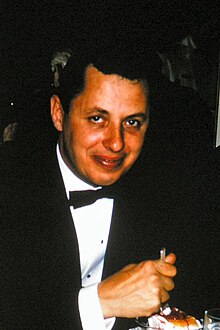Earl L. Muetterties
| Earl Leonard Muetterties | |
|---|---|
 |
|
| Born |
June 23, 1927 Elgin, Illinois |
| Died | January 12, 1984 (aged 56) Oakland, California |
| Residence | United States |
| Citizenship | United States |
| Fields | Inorganic chemistry |
| Institutions |
DuPont Central Research, Cornell University, University of California, Berkeley |
| Alma mater |
Northwestern University, Harvard University |
| Doctoral advisor |
Charles Brown and Eugene G. Rochow |
| Known for | Polyhedral boranes Fluxional processes in organometallic complexes Homogeneous catalysis Heterogeneous catalysis Apicophilicity |
| Notable awards | Senior U.S.. Scientist Award of the Humboldt Foundation ACS Award in Inorganic Chemistry (1965) Royal Society of Chemistry (RSC) Centenary Lectureship (1981) National Academy of Sciences |
Earl Muetterties (June 23, 1927 – January 12, 1984), was an American inorganic chemist born in Illinois, who is known for his experimental work with boranes, homogeneous catalysis, heterogeneous catalysis, fluxional processes in organometallic complexes and apicophilicity.
Muetterties earned a bachelor's degree in chemistry at Northwestern University in 1949 and received his doctoral thesis in boron-nitrogen chemistry under Charles Brown and Eugene G. Rochow at Harvard in 1952.
Earl Muetterties joined DuPont Central Research Department and was promoted to research supervisor in 1955. His early contributions were on the inorganic fluorine compounds, especially of sulfur and phosphorus. In collaboration with William D. Phillips he exploited NMR for study of dynamic processes in inorganic fluoride compounds. Muetterties's work on boron hydride clusters led to the work on several polyhedral borane anions such as B12H122−. Muetterties was an inventor on some basic findings with the polyhedral borate anions. In addition to the polyhedral boranes, the program explored pi-allyl, fluoroalkyl, and boron hydride complexes of the transition metals. Research also extended to stereochemically-non-rigid complexes. In 1965, he became Associate Director in the DuPont Central Research. In addition to groups in homogeneous and heterogeneous catalysis, groups were established in the synthesis and spectroscopy of organometallic compounds. He was also a prolific inventor.
...
Wikipedia
